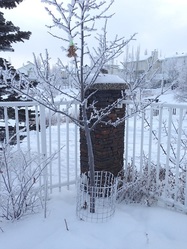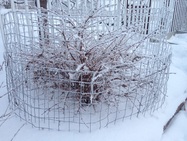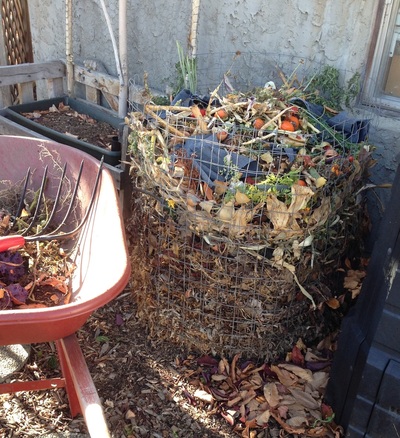
An easy way to protect trees and small shrub is with a wire fence. Here are some tips on what to buy and how to get extra mileage out of this product. I am a big proponent of the permaculture principle to “stack functions”, so I like to find many uses for an item or materials I purchase.
Materials
You will have to look, google or ask for the following terms, depending on the hardware store you visit: Welded Wire Fabric or Fence, Garden Fence, Rabbit Garden Fence
The gauge of these products is around 14. The larger the gauge, the thinner the wire and the floppier or weaker the fence is.
Suppliers in Edmonton and Area: Home Hardware, Home Depot, Lowe’s and maybe others.
Mesh Size
Ideally, you can find a sturdy product with a mesh size 2 inches by 2 inches or 2 inches by 1 inch. Larger mesh size is available, but you need to be careful – if you have small children, their hands may get trapped. A mesh size of 1 inch or smaller is usually a less sturdy product as well. It will work, but you will need to support it with stakes.
Poultry Netting, Chicken Wire or Hardware Cloth or most plastic products are generally very floppy and will not work without a frame. If you have lots of mice, you may need to use hardware cloth, which has a finer mesh to keep them from chewing all the way around the trunk of a tree.

For trees, create a sturdy wire cylinder around the trunk that has a diameter at least twice the size of the trunk. That way you don’t have to cut a new piece as the tree grows.
The height of the cage should be about 2 feet minimum. You want to be sure that a hare or jackrabbit cannot reach the lower branches or reach above the fence when we have a winter with lots of snow.
The rolls of fence are usually around 2 feet to 4 feet tall. I cut my wire closer to 3 feet tall, as I also use the cages for temporary compost bins when I don’t need them for plants (see more info below)
Shrubs grow much faster and you really only need to protect them for the first couple of years. Once the shrub is 2-3 feet tall and well branched, even heavy pruning by a rabbit will not kill the shrub.
With the welded wire fence, you will need to wear thick gloves and wire cutters. Place the fence around the trees and shrubs and use a pair of pliers to bend the cut wires and connect the fence into a cylinder. You can also use twist ties or plastic zap straps to connect the ends.
Stacking Functions – Using the Cages for Composting
The wire cages are really important when trees and shrubs are young, and during the winter when our local Jackrabbits have nothing else to eat. So eventually, you may not need all your cages or you only need them during the winter.
I like to connect together some extra welded wire fence to create larger cylinders (2.5-3.5 feet in diameter) for storing dry leaves or extra compost, and I have even used a cage with extra compost that needed more curing as a growing bed for cucumbers, melons and potatoes. Check out this blog post and photos below.


 RSS Feed
RSS Feed